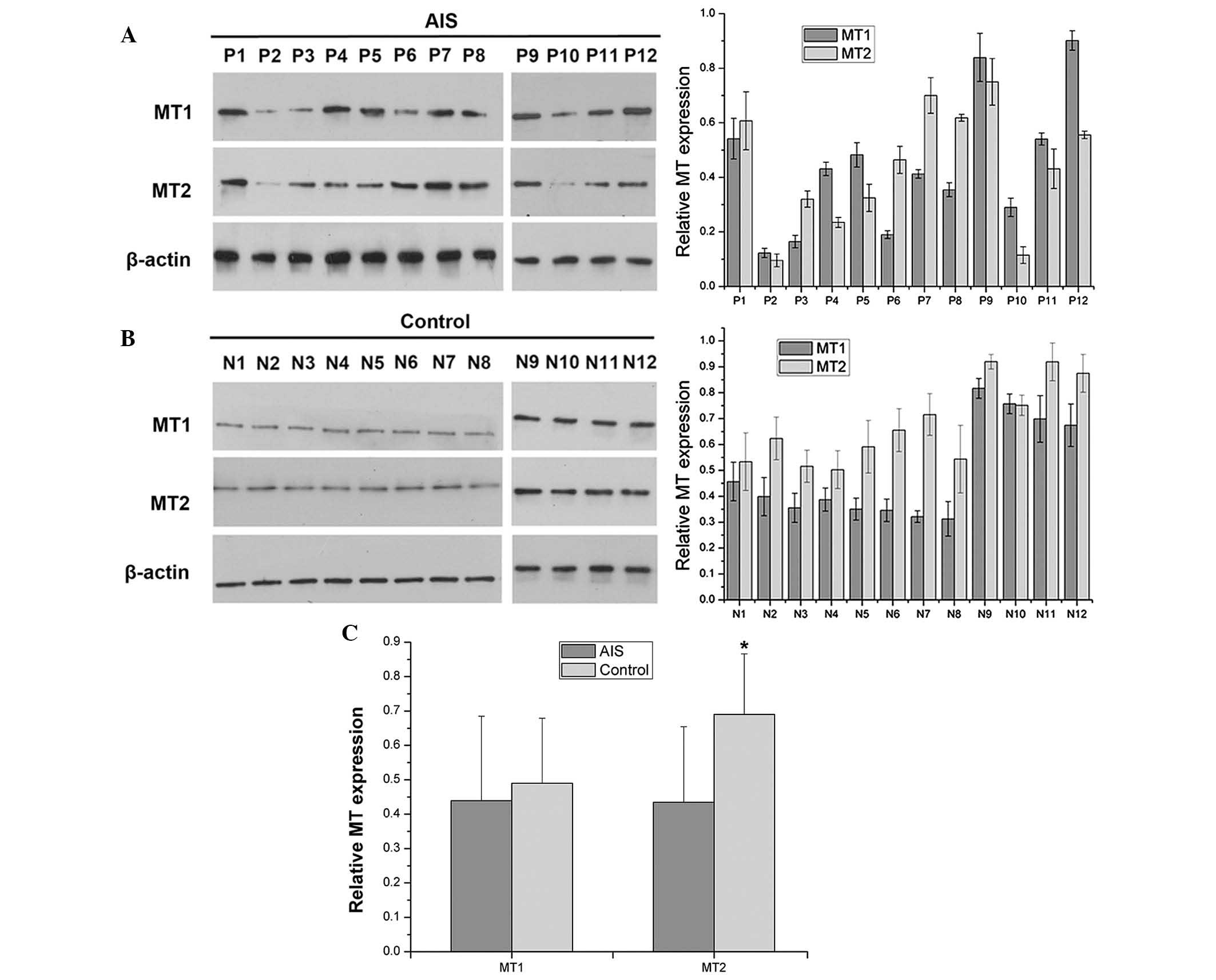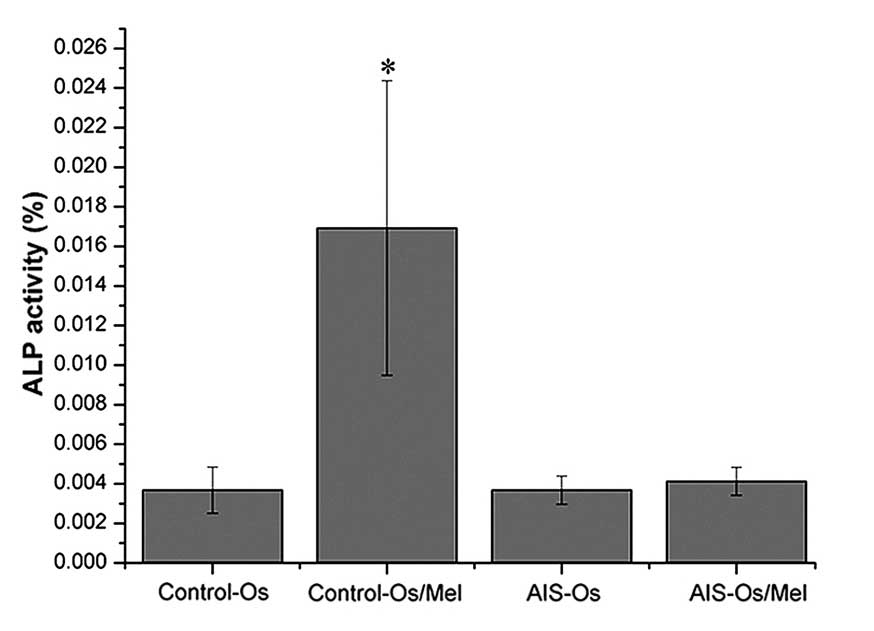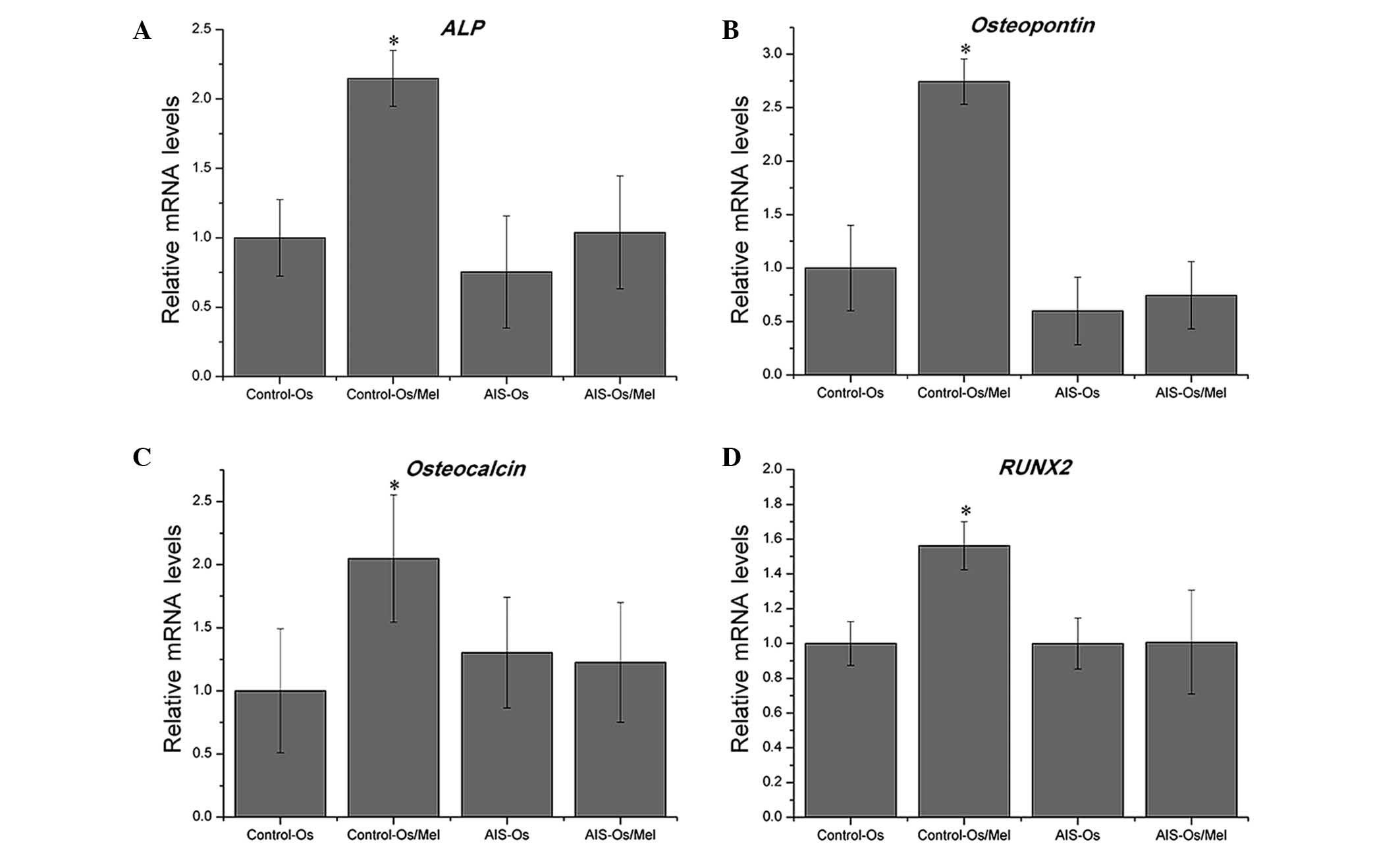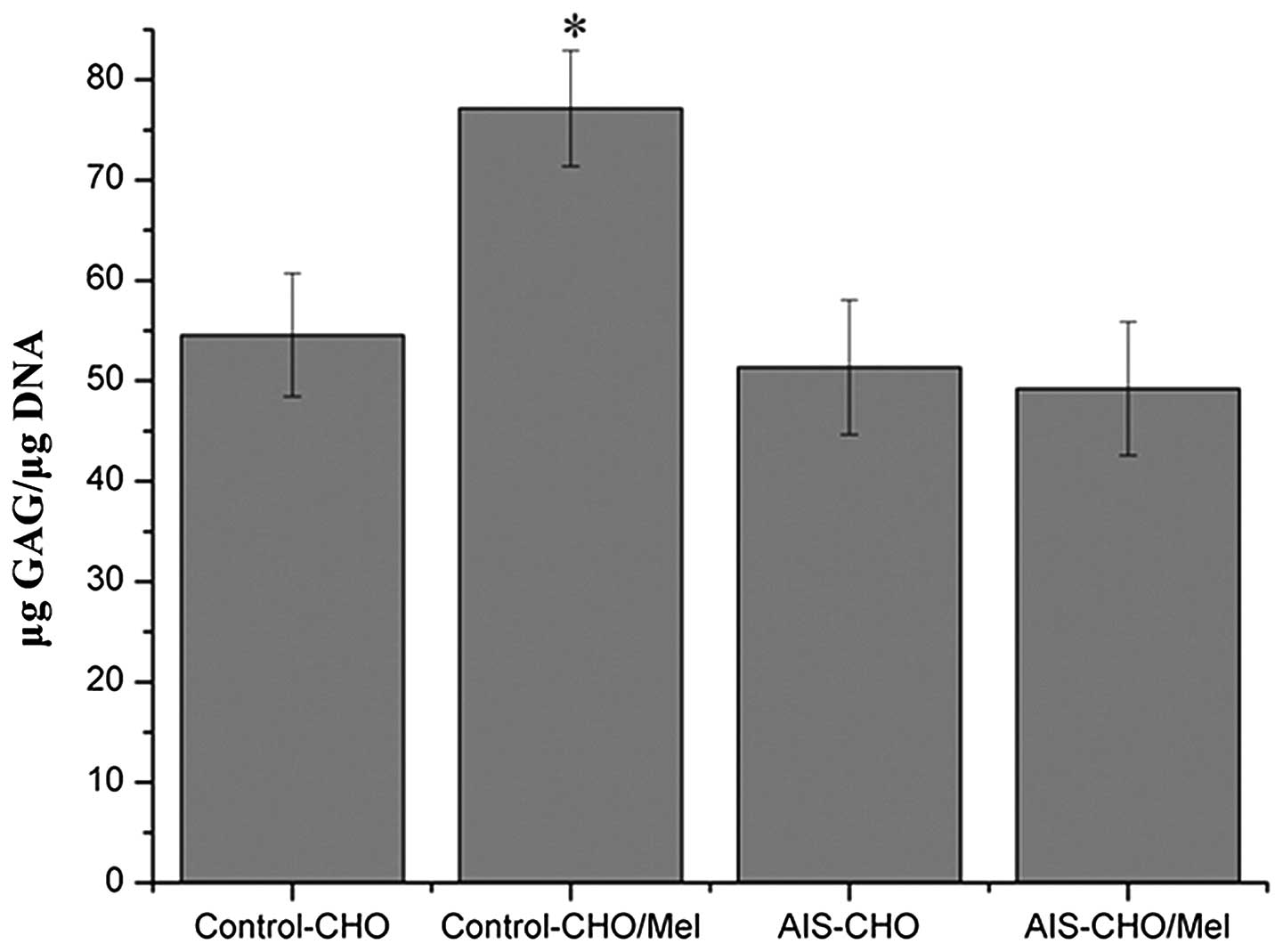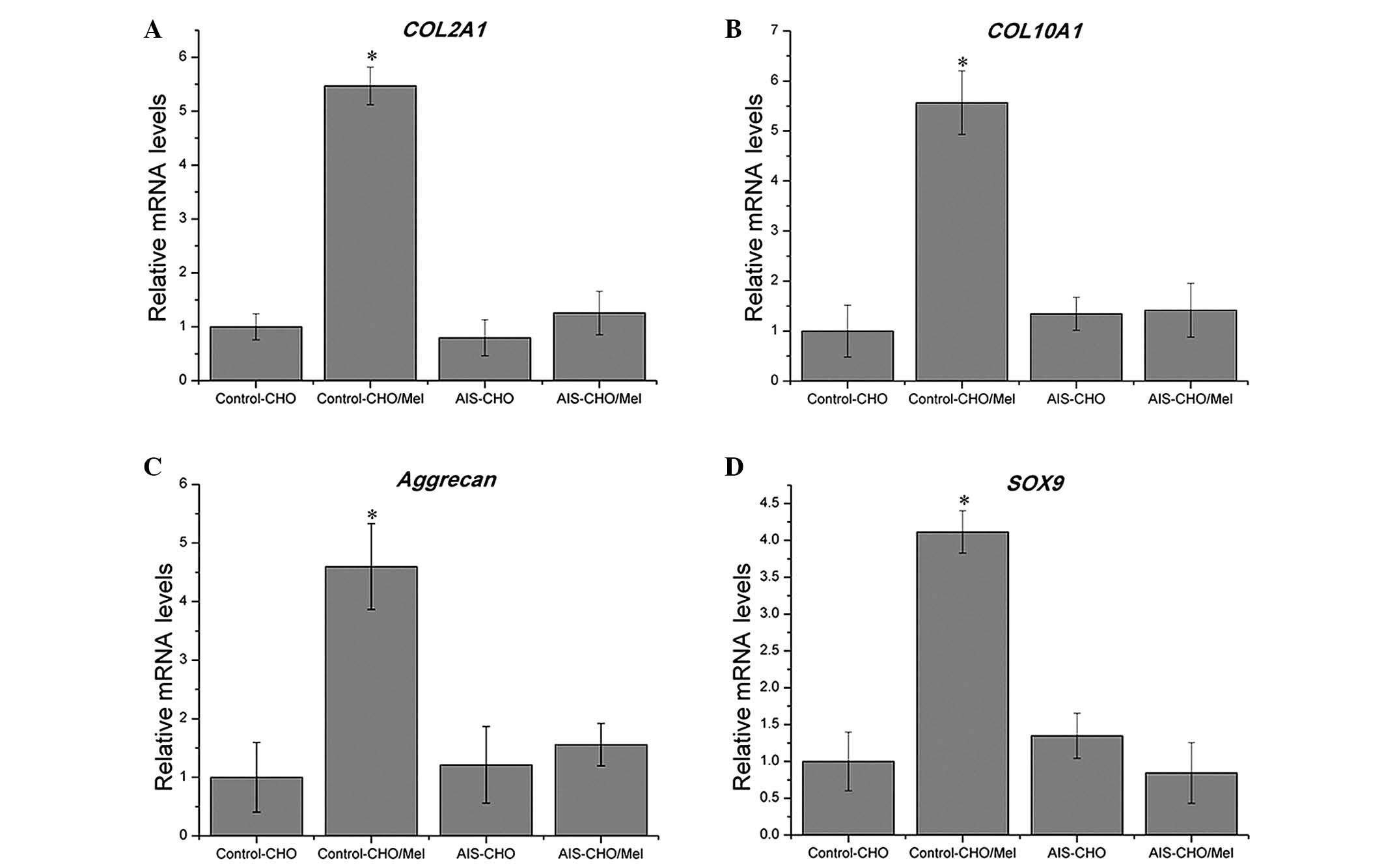|
1
|
Hresko MT: Clinical practice. Idiopathic
scoliosis in adolescents. N Engl J Med. 368:834–841. 2013.
View Article : Google Scholar : PubMed/NCBI
|
|
2
|
Wise CA, Gao X, Shoemaker S, Gordon D and
Herring JA: Understanding genetic factors in idiopathic scoliosis,
a complex disease of childhood. Curr Genomics. 9:51–59. 2008.
View Article : Google Scholar : PubMed/NCBI
|
|
3
|
Machida M: Cause of idiopathic scoliosis.
Spine (Phila Pa 1976). 24:2576–2583. 1999. View Article : Google Scholar
|
|
4
|
Cheung KM, Wang T, Qiu GX and Luk KD:
Recent advances in the aetiology of adolescent idiopathic
scoliosis. Int Orthop. 32:729–734. 2008. View Article : Google Scholar
|
|
5
|
Peng Y, Liang G, Pei Y, Ye W, Liang A and
Su P: Genomic polymorphisms of G-protein estrogen receptor 1 are
associated with severity of adolescent idiopathic scoliosis. Int
Orthop. 36:671–677. 2012. View Article : Google Scholar :
|
|
6
|
Kulis A, Goździalska A, Drag J, Jaśkiewicz
J, Knapik-Czajka M, Lipik E and Zarzycki D: Participation of sex
hormones in multifactorial pathogenesis of adolescent idiopathic
scoliosis. Int Orthop. 39:1227–1236. 2015. View Article : Google Scholar : PubMed/NCBI
|
|
7
|
Chu WC, Lam WW, Chan YL, Ng BK, Lam TP,
Lee KM, Guo X and Cheng JC: Relative shortening and functional
tethering of spinal cord in adolescent idiopathic scoliosis? Study
with multiplanar reformat magnetic resonance imaging and
somatosensory evoked potential. Spine (Phila Pa 1976). 31:E19–E25.
2006. View Article : Google Scholar
|
|
8
|
Cheng JC, Hung VW, Lee WT, Yeung HY, Lam
TP, Ng BK, Guo X and Qin L: Persistent osteopenia in adolescent
idiopathic scoliosis-longitudinal monitoring of bone mineral
density until skeletal maturity. Stud Health Technol Inform.
123:47–51. 2006.
|
|
9
|
Guo X, Chau WW, Chan YL and Cheng JC:
Relative anterior spinal overgrowth in adolescent idiopathic
scoliosis. Results of disproportionate endochondral-membranous bone
growth. J Bone Joint Surg Br. 85:1026–1031. 2003. View Article : Google Scholar : PubMed/NCBI
|
|
10
|
Qiu XS, Tang NL, Yeung HY, Lee KM, Hung
VW, Ng BK, Ma SL, Kwok RH, Qin L, Qiu Y and Cheng JC: Melatonin
receptor 1B (MTNR1B) gene polymorphism is associated with the
occurrence of adolescent idiopathic scoliosis. Spine (Phila Pa
1976). 32:1748–1753. 2007. View Article : Google Scholar
|
|
11
|
Qiu Y, Wu L, Wang B, Yu Y and Zhu Z:
Asymmetric expression of melatonin receptor mRNA in bilateral
paravertebral muscles in adolescent idiopathic scoliosis. Spine
(Phila Pa 1976). 32:667–672. 2007. View Article : Google Scholar
|
|
12
|
Lombardi G, Akoume MY, Colombini A, Moreau
A and Banfi G: Biochemistry of adolescent idiopathic scoliosis. Adv
Clin Chem. 54:165–182. 2011. View Article : Google Scholar : PubMed/NCBI
|
|
13
|
Azeddine B, Letellier K, Wang da S,
Moldovan F and Moreau A: Molecular determinants of melatonin
signaling dysfunction in adolescent idiopathic scoliosis. Clin
Orthop Relat Res. 462:45–52. 2007. View Article : Google Scholar : PubMed/NCBI
|
|
14
|
Moreau A, Wang DS, Forget S, Azeddine B,
Angeloni D, Fraschini F, Labelle H, Poitras B, Rivard CH and
Grimard G: Melatonin signaling dysfunction in adolescent idiopathic
scoliosis. Spine (Phila Pa 1976). 29:1772–1781. 2004. View Article : Google Scholar
|
|
15
|
Man GC, Wang WW, Yeung BH, Lee SK, Ng BK,
Hung WY, Wong JH, Ng TB, Qiu Y and Cheng JC: Abnormal proliferation
and differentiation of osteoblasts from girls with adolescent
idiopathic scoliosis to melatonin. J Pineal Res. 49:69–77.
2010.PubMed/NCBI
|
|
16
|
Man GC, Wong JH, Wang WW, Sun GQ, Yeung
BH, Ng TB, Lee SK, Ng BK, Qiu Y and Cheng JC: Abnormal melatonin
receptor 1B expression in osteoblasts from girls with adolescent
idiopathic scoliosis. J Pineal Res. 50:395–402. 2011. View Article : Google Scholar : PubMed/NCBI
|
|
17
|
Bruder SP, Fink DJ and Caplan AI:
Mesenchymal stem cells in bone development, bone repair, and
skeletal regeneration therapy. J Cell Biochem. 56:283–294. 1994.
View Article : Google Scholar : PubMed/NCBI
|
|
18
|
Kelly DJ and Jacobs CR: The role of
mechanical signals in regulating chondrogenesis and osteogenesis of
mesenchymal stem cells. Birth Defects Res C Embryo Today. 90:75–85.
2010. View Article : Google Scholar : PubMed/NCBI
|
|
19
|
Zhang L, Su P, Xu C, Chen C, Liang A, Du
K, Peng Y and Huang D: Melatonin inhibits adipogenesis and enhances
osteogenesis of human mesenchymal stem cells by suppressing PPARγ
expression and enhancing Runx2 expression. J Pineal Res.
49:364–372. 2010. View Article : Google Scholar : PubMed/NCBI
|
|
20
|
Zhang L, Zhang J, Ling Y, Chen C, Liang A,
Peng Y, Chang H, Su P and Huang D: Sustained release of melatonin
from poly (lactic-co-glycolic acid) (PLGA) microspheres to induce
osteogenesis of human mesenchymal stem cells in vitro. J Pineal
Res. 54:24–32. 2013.
|
|
21
|
Gao W, Lin M, Liang A, Zhang L, Chen C,
Liang G, Xu C, Peng Y, Chen C, Huang D and Su P: Melatonin enhances
chondrogenic differentiation of human mesenchymal stem cells. J
Pineal Res. 56:62–70. 2014. View Article : Google Scholar
|
|
22
|
Zhang L, Su P, Xu C, Yang J, Yu W and
Huang D: Chondrogenic differentiation of human mesenchymal stem
cells: A comparison between micromass and pellet culture systems.
Biotechnol Lett. 32:1339–1346. 2010. View Article : Google Scholar : PubMed/NCBI
|
|
23
|
Livak KJ and Schmittgen TD: Analysis of
relative gene expression data using real-time quantitative PCR and
the 2(-Delta Delta C(T)) method. Methods. 25:402–408. 2001.
View Article : Google Scholar
|
|
24
|
von Gall C, Stehle JH and Weaver DR:
Mammalian melatonin receptors: Molecular biology and signal
transduction. Cell Tissue Res. 309:151–162. 2002. View Article : Google Scholar : PubMed/NCBI
|
|
25
|
Qiu XS, Tang NL, Yeung HY, Cheng JC and
Qiu Y: Lack of association between the promoter polymorphism of the
MTNR1A gene and adolescent idiopathic scoliosis. Spine (Phila Pa
1976). 33:2204–2207. 2008. View Article : Google Scholar
|
|
26
|
Nelson LM, Ward K and Ogilvie JW: Genetic
variants in melatonin synthesis and signaling pathway are not
associated with adolescent idiopathic scoliosis. Spine (Phila Pa
1976). 36:37–40. 2011. View Article : Google Scholar
|
|
27
|
Wang WW, Man GC, Wong JH, Ng TB, Lee KM,
Ng BK, Yeung HY, Qiu Y and Cheng JC: Abnormal response of the
proliferation and differentiation of growth plate chondrocytes to
melatonin in adolescent idiopathic scoliosis. Int J Mol Sci.
15:17100–17114. 2014. View Article : Google Scholar : PubMed/NCBI
|
|
28
|
Yim AP, Yeung HY, Sun G, Lee KM, Ng TB,
Lam TP, Ng BK, Qiu Y, Moreau A and Cheng JC: Abnormal skeletal
growth in adolescent idiopathic scoliosis is associated with
abnormal quantitative expression of melatonin receptor, MT2. Int J
Mol Sci. 14:6345–6358. 2013. View Article : Google Scholar : PubMed/NCBI
|
|
29
|
Radio NM, Doctor JS and Witt-Enderby PA:
Melatonin enhances alkaline phosphatase activity in differentiating
human adult mesenchymal stem cells grown in osteogenic medium via
MT2 melatonin receptors and the MEK/ERK (1/2) signaling cascade. J
Pineal Res. 40:332–342. 2006. View Article : Google Scholar : PubMed/NCBI
|
|
30
|
Nakade O, Koyama H, Ariji H, Yajima A and
Kaku T: Melatonin stimulates proliferation and type I collagen
synthesis in human bone cells in vitro. J Pineal Res. 27:106–110.
1999. View Article : Google Scholar : PubMed/NCBI
|
|
31
|
Roth JA, Kim BG, Lin WL and Cho MI:
Melatonin promotes osteoblast differentiation and bone formation. J
Biol Chem. 274:22041–22047. 1999. View Article : Google Scholar : PubMed/NCBI
|
|
32
|
Park KH, Kang JW, Lee EM, Kim JS, Rhee YH,
Kim M, Jeong SJ, Park YG and Kim SH: Melatonin promotes
osteoblastic differentiation through the BMP/ERK/Wnt signaling
pathways. J Pineal Res. 51:187–194. 2011. View Article : Google Scholar : PubMed/NCBI
|
|
33
|
Satomura K, Tobiume S, Tokuyama R,
Yamasaki Y, Kudoh K, Maeda E and Nagayama M: Melatonin at
pharmacological doses enhances human osteoblastic differentiation
in vitro and promotes mouse cortical bone formation in vivo. J
Pineal Res. 42:231–239. 2007. View Article : Google Scholar : PubMed/NCBI
|
|
34
|
Liu J, Zhou H, Fan W, Dong W, Fu S, He H
and Huang F: Melatonin influences proliferation and differentiation
of rat dental papilla cells in vitro and dentine formation in vivo
by altering mitochondrial activity. J Pineal Res. 54:170–178. 2013.
View Article : Google Scholar :
|
|
35
|
Burner WL III, Badger VM and Sherman FC:
Osteoporosis and acquired back deformities. J Pediatr Orthop.
2:383–385. 1982. View Article : Google Scholar : PubMed/NCBI
|
|
36
|
Cheng JC and Guo X: Osteopenia in
adolescent idiopathic scoliosis. A primary problem or secondary to
the spinal deformity? Spine (Phila Pa 1976). 22:1716–1721. 1997.
View Article : Google Scholar
|
|
37
|
Cheng JC, Guo X and Sher AH: Persistent
osteopenia in adolescent idiopathic scoliosis. A longitudinal
follow up study. Spine (Phila Pa 1976). 24:1218–1222. 1999.
View Article : Google Scholar
|
|
38
|
Yu WS, Chan KY, Yu FW, Yeung HY, Ng BK,
Lee KM, Lam TP and Cheng JC: Abnormal bone quality versus low bone
mineral density in adolescent idiopathic scoliosis: A case-control
study with in vivo high-resolution peripheral quantitative computed
tomography. Spine J. 13:1493–1499. 2013. View Article : Google Scholar : PubMed/NCBI
|
|
39
|
Zhu F, Qiu Y, Yeung HY, Lee KM and Cheng
JC: Histomorphometric study of the spinal growth plates in
idiopathic scoliosis and congenital scoliosis. Pediatr Int.
48:591–598. 2006. View Article : Google Scholar : PubMed/NCBI
|
|
40
|
Aota Y, Terayama H, Saito T and Itoh M:
Pinealectomy in a broiler chicken model impairs endochondral
ossification and induces rapid cancellous bone loss. Spine J.
13:1607–1616. 2013. View Article : Google Scholar : PubMed/NCBI
|
|
41
|
Dickson RA, Lawton JO, Archer IA and Butt
WP: The pathogenesis of idiopathic scoliosis. Biplanar spinal
asymmetry. J Bone Joint Surg Br. 66:8–15. 1984.PubMed/NCBI
|
|
42
|
Parent S, Labelle H, Skalli W, Latimer B
and de Guise J: Morphometric analysis of anatomic scoliotic
specimens. Spine (Phila Pa 1976). 27:2305–2311. 2002. View Article : Google Scholar
|
|
43
|
Dayer R, Haumont T, Belaieff W and
Lascombes P: Idiopathic scoliosis: Etiological concepts and
hypotheses. J Child Orthop. 7:11–16. 2013. View Article : Google Scholar :
|



